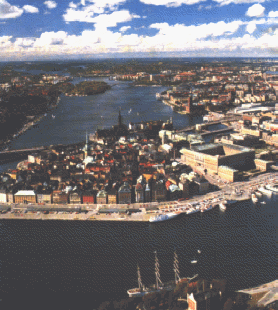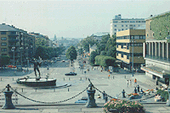The swedish geography
![]() The Geography
The Geography
Sweden is a large (449964 square kilometers) and a sparsely
populated country (18 inhabitants / km²)
This scandinavian country is situated in northern Europe, close to the Artic Circle
and is surrended with Norway and Finland.
Its shape represents with some imagination a banana whose length is 1575 km and width is 499 km.

Sweden is formed by 24 counties or
län, shared out among 3 regions:
- Götaland: Scanie,Halland,Blekinge,
Bohuslän, Småland, Västergötland, Östergötland et Gotland,
- Svealand: Stockholm, Uppland,Södermanland, Västermanland, Närke,
Värmland et Dalecarlie,
- Norrland: Gästrikland, Hälsingland, Härjedalen, Jämtland, Medelpad,
Ångermanland, Västerbotten, Norrbotten et la Laponie.
The forest is very important and recovers the half of
Sweden. Only 1/10 of lands is cultivated by farmers.
Sweden is a flat country, scattered with 100.000 lakes. The lakes represent around 10% of the total surface. The two largest lakes are Vänern and Vättern, situated in the south part of Sweden.
Even if the relief is quite flat, you can find close to
Norway "the Swedish Alps" whose top, Kebnekaise, is 2117m at its highest point.
From these mountains run many rivers to the Botnie Gulf. The name of the main rivers
are: Ångermanälven, Dalälven,
Umeälven and Torne älv.
Around 1500000 islands are along the Swedish coasts and was warmed by the Gulf Stream. Thanks to this privileged situation, Sweden has a milder climate than the other scandinavian countries.
 The Swedish capitale, Stockholm, is a
wonder and called "Venice of North", "Queen of Mälar lake" or
"the beauty on water". The city got these nicknames because of its building on
14 islands.
The Swedish capitale, Stockholm, is a
wonder and called "Venice of North", "Queen of Mälar lake" or
"the beauty on water". The city got these nicknames because of its building on
14 islands.
Under the Regency of Biger Jarl (13rd
century), Stockholm became the capitale of Sweden.
The city knew many historical events as the blood bath in 1520.
The charms of Stockholm come to light during the walking in
the historical city called Gamla Stan, in Skansen, the outdoor museum, or during a visit
to the many museums as Historiska Museet, Vasamuseet...
The Stockholm' Subway, called Tunnelbana, is a curiosity because it is a wonderful Art Gallery. On 100 stations, you can find paintings, sculptures, engraving or insects...

Göteborg, second largest city of
Sweden,
is situated on the west coast and amounts to 437313 inhabitants.
The first colonies settled close to Göteborg from the 11th century, in a city
called Nya Lödöse.
The geographical closeness with Danemark had many dramatic influences on the
calmness of Nya Lödöse. Actually,the city was destroyed many times.
Everyone who wants to visit Göteborg will notice its architectural particularity influenced by the Dutch model (red bricks, buildings with sloping roofs).
The city was populated from the 17th century by many dutches who wanted to give a dutch touch to the city.
Göteborg is also known as the most important harbour in the
northern Europe. The first ship built in Göteborg was launched in 1637 and was called
"Nya sverige".
The west Indies Company exercised its activities in Göteborg during
100 years.
Nowadays the city has kept this industrial and commercial features because
Göteborg is stayed a main center of economic growth in Sweden.
If you come to Göteborg, do not miss to visit "konhuset", "Domkyrkan", the famous amusement park"Liseberg", konstmuseet with its very interesting exhibitions and without forgetting the famous Götaplats where you could admire the Poseidon fountain.

Malmö, the third swedish city with 237438
inhabitants, is an important commercial and fishing center thanks to the
Öresund, the most
frequented sea in Europe and thanks to its closeness with Germany, Denmark and
Poland.
Malmö is also the most important city in Scanie, the first agricultural region in
Sweden.
The most famous place to visit in Malmö are
Stortorget, the city hall, Residenset, Jörg Kock Hus, Lillatorget, MalmöHus
castle and the St-Peter Church.
Close to Malmö, I advice you to visit Lund, where you can see the oldest university in Europe.
![]() The Climate
The Climate
Two seasons exist in the Swedish life: winter and summer.
The cold and long winters give way to the bright and hot summers. The winter clothes its dark black coat whereas the summer lights up its splendid minight sun.
Actually, around the Saint John's Day called Midsommar, the day lastes 19 hours in Stockholm and 24 hours in Laponia. There is a minight sun from the end of may to mid july.
Situated close to the Artic circle, Sweden has however a
moderated climate. Actually, the main mild influences come from the Gulf Stream and some
hot western winds.
But in the winter, the temperature are really low because of the cold winds come from the estern but in the north of Sweden the climate is more
severe.
![]() The population
The population
At the present time, the Swedish population comes to 8,8
millions of inhabitants (including 17000 Lapps).
The reproduction rate is around 2,1 children per woman that means there are enough
children born in the country. If the rate is below 2,1, that means there are more elderly
persons than younger ones.
The majority of swedes (around 85%) lives in the south part
of Sweden and especially in the three big cities, Stockholm, Göteborg and Malmö.
The density of population is around 18 inhabitants / square kilometers.
In Sweden, the life is pleasant. Actually, the life expectancy is high, 76 years old for men and 81 years old for women.
Regarding the religion, the most of swedes belong to the Lutherian Church.